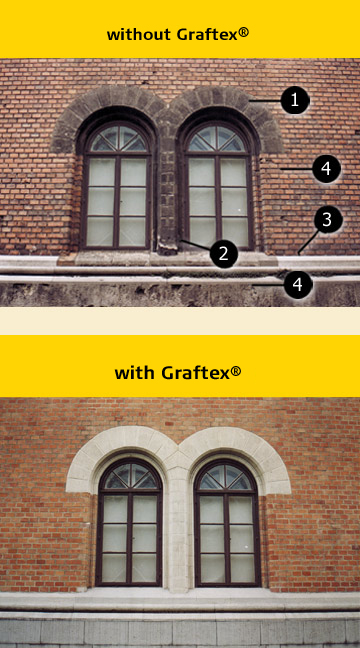|
|
|
|
 |
 |
 |
Hydrofuge > Brick and stone |
 |
The choice is yours...
 |
- Industry and traffic are major air
polluters. The burning of oil derivitives
and coal produces sulphur dioxides
which turn into sulphuric acid. Nitrogen oxide is produced by the internal combustion engine and becomes nitric acid. Natural stone is composed mainly
of lime, which is sensitive to acid rain.
- A crust can form on the surface of stone and brick composed
of soot and a dusty amalgam of previously-described pollutants.
When this happens, a layer
of calcium sulfate (patina) is deposited
which is hardly permeable at all to water.
The moisture within the stone accu-mulates beneath the patina layer. Sait crystallization leads to volume expansion, and the stone begins to crumble.
For this reason it is extremely important to prevent water penetration without affecting the vapour diffusion properties
of the stone.
- Micro-organisms proliferate when brick
and stone are exposed
to damp
conditions. The clearest sign of these is the formation
of moss and algae: they give rise to continuous maintenance and
its consequent cost. Moss and algae also hold back moisture, which
increases the risk of frost damage.
- Water that penetrates through capillary action or cracks can
cause an expansion
of volume that can reach as high as
10%, which
in turn can cause brick or stone to crumble. Certain mortars,
such
as those used as filler between bricks
and stones, can begin
to erode or cause displacement with the repetition of freeze/thaw
cycles.
|
 |
Graftex® protects against:
1)-
Gases, preventing penetration of carbon dioxide and sulphur dioxide.
2)-
Rain, preventing infiltration of acidic or sulphurous water. |
 |
Graftex® forms an impermeable layer against heavy rains, while
allowing the substrate to breathe and therefore regulate humidity
levels. 198 g.m/2 in 24 hours. |
 |
Graftex® is an aqueous emulsion made from acrylic resin. These components are completely harmless, yet discourage the fixation
of micro-organisms and grime by plugging pores and fissures
of <0.3 mm. |
 |
What's more, Graftex® has an elasticity rate of +/-150%, which
allows it to withstand the superficial expansion and contraction of
stone and brick. |
|
|
|